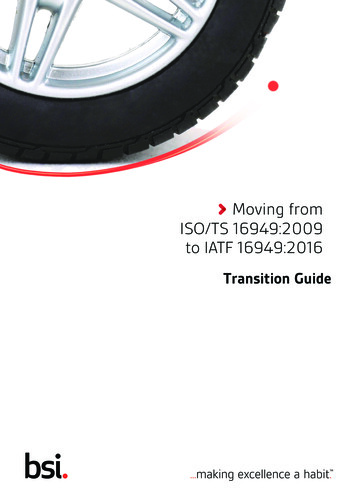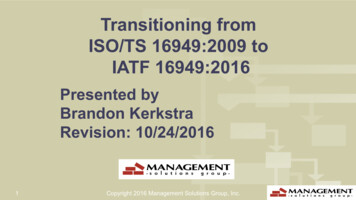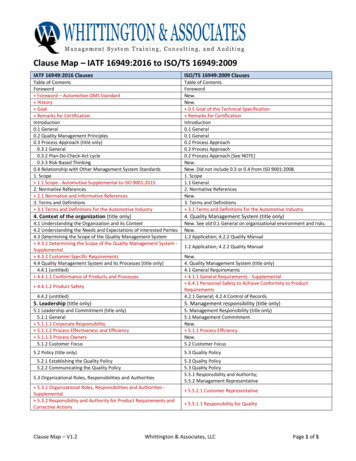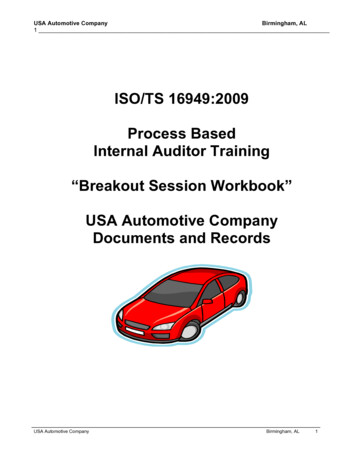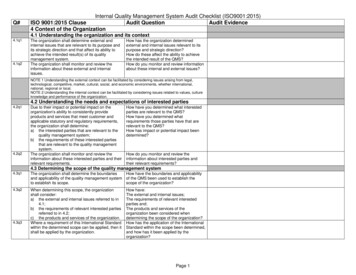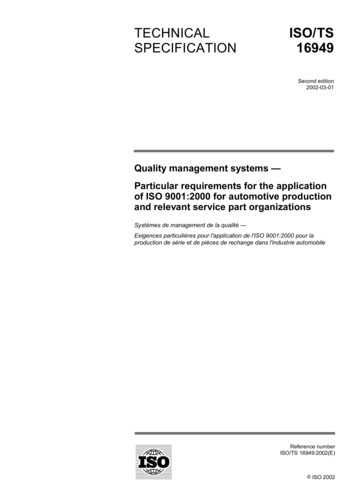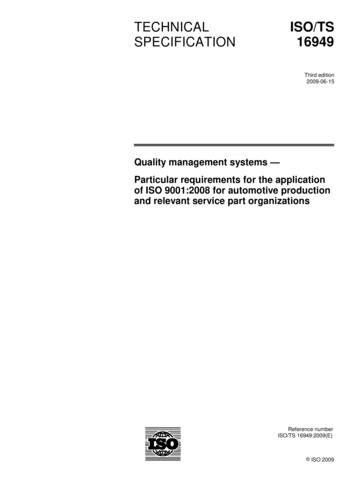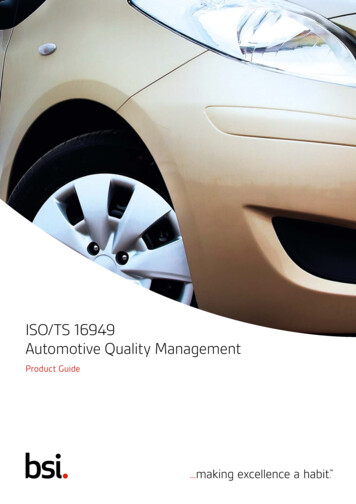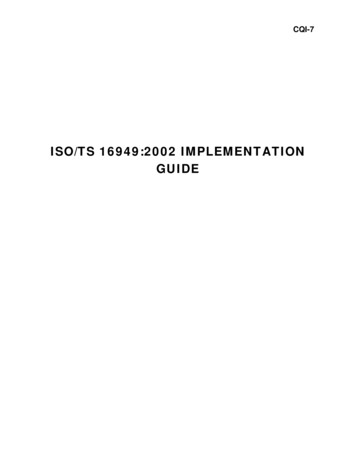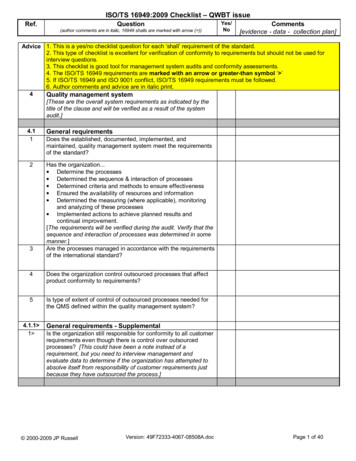
Transcription
ISO/TS 16949:2009 Checklist – QWBT issueRef.Question(author comments are in italic, 16949 shalls are marked with arrow ( ))Yes/NoComments[evidence - data - collection plan]Advice 1. This is a yes/no checklist question for each ‘shall’ requirement of the standard.2. This type of checklist is excellent for verification of conformity to requirements but should not be used forinterview questions.3. This checklist is good tool for management system audits and conformity assessments.4. The ISO/TS 16949 requirements are marked with an arrow or greater-than symbol ‘ ’5. If ISO/TS 16949 and ISO 9001 conflict, ISO/TS 16949 requirements must be followed.6. Author comments and advice are in italic print.4Quality management system[These are the overall system requirements as indicated by thetitle of the clause and will be verified as a result of the systemaudit.]4.1123General requirementsDoes the established, documented, implemented, andmaintained, quality management system meet the requirementsof the standard?Has the organization. Determine the processes Determined the sequence & interaction of processes Determined criteria and methods to ensure effectiveness Ensured the availability of resources and information Determined the measuring (where applicable), monitoringand analyzing of these processes Implemented actions to achieve planned results andcontinual improvement.[The requirements will be verified during the audit. Verify that thesequence and interaction of processes was determined in somemanner.]Are the processes managed in accordance with the requirementsof the international standard?4Does the organization control outsourced processes that affectproduct conformity to requirements?5Is type of extent of control of outsourced processes needed forthe QMS defined within the quality management system?4.1.1 1 General requirements - SupplementalIs the organization still responsible for conformity to all customerrequirements even though there is control over outsourcedprocesses? [This could have been a note instead of arequirement, but you need to interview management andevaluate data to determine if the organization has attempted toabsolve itself from responsibility of customer requirements justbecause they have outsourced the process.] 2000-2009 JP RussellVersion: 49F72333-4067-08508A.docPage 1 of 40
ISO/TS 16949:2009 Checklist – QWBT issueRef.Question(author comments are in italic, 16949 shalls are marked with arrow ( ))4.24.2.114.2.2124.2.31Yes/NoComments[evidence - data - collection plan]Documentation requirementsGeneralDoes the QMS documentation include:a) quality policy and objectivesb) a quality manualc) documented procedures and records as required by thisstandardd) documents and records required by the organization foreffective planning operation and control[ISO 9001 requires six documented procedures for 6 QMScontrols, but there may be more than or less than 6documented procedures to address the requirements.]Quality ManualIs there a quality manual that includes the scope of the QMS,justification for exclusions, and describes the interaction betweenthe processes? The manual must be documented, but nomedium is specified.Does the manual contain documented procedures or are theyreferenced?Control of documentsAre required QMS documents controlled? [Identified in 4.2.1.Documents required by the organization need to be identified insome manner.]2Are there written procedures to control all documents (electronicor hard copy media) required for operating the qualitymanagement system? Are they being used?3Are documents approved for adequacy prior to release. [Theremay be a need for both content approval and approval forauthority to deploy, which may or may not be the same.]4Are documents reviewed, updated as necessary, and then reapproved?5Is there a method that identifies the current version status ofdocuments?6Are documents (procedures, instructions) available at points ofuse (locations where quality activities are performed)?7Are documents legible and readily identifiable?8Are external origin documents necessary for the planning andoperation of the QMS identified and distribution controlled? 2000-2009 JP RussellVersion: 49F72333-4067-08508A.docPage 2 of 40
ISO/TS 16949:2009 Checklist – QWBT issueRef.Question(author comments are in italic, 16949 shalls are marked with arrow ( ))9Yes/NoComments[evidence - data - collection plan]Are obsolete documents (retained for legal and/or knowledgepurposes) suitably identified to prevent unintended use. 2000-2009 JP RussellVersion: 49F72333-4067-08508A.docPage 3 of 40
ISO/TS 16949:2009 Checklist – QWBT issueRef.Question(author comments are in italic, 16949 shalls are marked with arrow ( ))Yes/NoComments[evidence - data - collection plan]4.2.3.1 Engineering specifications1 Does the organization have a process to assure the timelyreview, distribution and implementation of all customerengineering standards/specifications and changes based oncustomer-required schedule?2 Is the review (of customer engineering standards/specificationsand changes) conducted within two working weeks?3 Is there a record of the date on which each change isimplemented in production?4 Does implementation of changes include updated (changed)documents? 16949 NOTE: A change in thesestandards/specifications requires an updated record of customerproduction part approval when these specifications arereferenced on the design record or if they affect documents ofproduction part approval process, such as a control plan,FMEAs, etc.4.2.41Control of records 16949 NOTE: “Records” also include customer-specifiedrecordsAre there documented procedures for identifying, storing,retrieval, protection, retention, and disposition of records? Arethey being used? 16949 NOTE “Disposition” above includes disposal.2Are records legible, readily identifiable, and retrievable?3Are required records established and controlled?4.2.4.1 Record Retention1 Do records control satisfy regulatory and customerrequirements?List of required records 2000-2009 JP RussellVersion: 49F72333-4067-08508A.docPage 4 of 40
ISO/TS 16949:2009 Checklist – QWBT issueRef.Question(author comments are in italic, 16949 shalls are marked with arrow ( ))Yes/NoComments[evidence - data - collection plan]Do the following records exist: Date changes implemented in production (4.2.3.1)Management review (5.6.1) Achievement of quality objectives and customer satisfaction ofproduct supplied (5.6.1.1)Personnel training (6.2.2)Conformity of processes and products (7.1)Review of customer requirements (7.2.2)Design and development inputs (7.3.2)Design reviews (7.3.4)Design verification (7.3.5)Record of validation results (7.3.6)Review of design changes and actions (7.3.7)Supplier evaluations (7.4.1)Process validation (qualification) (7.5.2)Product identification where traceability is required (7.5.3)Unsuitable customer product (7.5.4)Results of calibration (7.6)Record of non-standard calibration (7.6)Validity of previous results (7.6) Calibration/verification activities to provide evidence ofconformity of product (7.6.2)Results of internal audits (8.2.2) Significant process events, i.e. repairs (8.2.3.1) Effective dates of process changes (8.2.3.1)Verification that product passed tests (8.2.4)Record of nonconforming product and actions (8.3) Customer waiver expiration date and quantity (8.3.4)Results and corrective action taken (8.5.2) Analysis of parts rejected (8.5.2.4)Results and preventive action taken (8.5.3) 2000-2009 JP RussellVersion: 49F72333-4067-08508A.docPage 5 of 40
ISO/TS 16949:2009 Checklist – QWBT issueRef.Question(author comments are in italic, 16949 shalls are marked with arrow ( ))5Management Responsibility5.11Management commitmentYes/NoComments[evidence - data - collection plan]Is there evidence of top management commitment by:a) Communicating the importance of meeting customer andregulatory requirements;b) Establishing a quality policyc) Ensuring there are quality objectives;d) Conducting management reviews; ande) Ensuring availability of resources.[Verify a through e. See quality policy, verify managementreviews taking place and top management involved. a) is linkedto 5.5.2 c)]5.1.1 Process efficiency1 Does top management review the product realization processesand the support processes to assure their effectiveness andefficiency?5.2Customer focus15.3Does top management ensure customer requirements aredetermined and met, with an aim to enhancing customersatisfaction?[This requirement is linked to 7.2. If there is a 7.2 nonconformity,there may be 5.2 nonconformity. If the organization is notmeasuring ‘customer satisfaction’ (8.2.1), or if there is no aim(goal) for enhancing customer satisfaction, there could be anonconformity.]Quality policy1Has top management ensured there is a quality policy2Is the policy appropriate for the purpose of the organization?3Does the policy include commitment to meeting requirementsand continual improvement?4Does the policy statement include provision for:- providing a framework for establishing/ reviewing objectives?- reviewing for continuing suitability of the policy?[Note: Reviewing should link with management review (5.6) ofthe suitability of the quality system.]Has the quality policy been communicated, understood andimplemented within of the organization? [Note it does not saymemorized, although that’s one way of demonstrating that it’sbeen communicated, A paraphrased answer may be betterbecause it would demonstrate understanding. Interviewees canalso be asked to explain what it means to them.]5 2000-2009 JP RussellVersion: 49F72333-4067-08508A.docPage 6 of 40
ISO/TS 16949:2009 Checklist – QWBT issueRef.Question(author comments are in italic, 16949 shalls are marked with arrow ( ))5.45.4.112Yes/NoComments[evidence - data - collection plan]PlanningQuality objectivesAre objectives established for each relevant function and level?Are the objectives measurable and consistent with the qualitypolicy including a commitment to continual improvement?[Note: Seek to determine relevant functions (such as from anorganizational chart) and verify that there are objectives foreach.]Do objectives include those needed to meet requirements forproducts and/or services?[Note: This requirement is linked to 7.1. For example: objectivesmust include product requirements such as purity or tolerancelevels. There may be a matrix (not required) to show relationshipbetween objectives and product/ service requirements.]5.4.1.1 Quality objectives — Supplemental1 Does top management define quality objectives andmeasurements? 16949 NOTE: Quality objectives should address customerexpectations and be achievable within a defined time period.2 5.4.2125.55.5.11Are quality objectives and measurements included in thebusiness plan and used to deploy the quality policy?Quality management system planningDoes top management ensure QMS planning is carried out tomeet quality objectives and requirements in clause 4.1?When organizational changes are planned and implemented, isthe integrity of the management system maintained during thechange? [Note: How does management ensure integrity ismaintained? Is there a method or records of actions? ]Responsibility, authority, and communicationResponsibility and authorityHave functions responsibility and authority, been defined andcommunicated?[May be defined in job descriptions & communicated viaorganization charts, outline, and so on.]5.5.1.1 Responsibility for quality1 Are managers with responsibility and authority for correctiveaction promptly informed of products or processes which do notconform to requirements? [Auditors can identify a situation whena process does not conform and then ask the manager if theywere informed. A record such as an e-mail or note would verifythe communications.] 2000-2009 JP RussellVersion: 49F72333-4067-08508A.docPage 7 of 40
ISO/TS 16949:2009 Checklist – QWBT issueRef.Question(author comments are in italic, 16949 shalls are marked with arrow ( ))2 Do personnel responsible for product quality have the authorityto stop production to correct quality problems?3 Are all production operating shifts staffed with personnel incharge of, or delegated responsibility for,ensuring productquality?5.5.2123Yes/NoComments[evidence - data - collection plan]Management representativeHas top management appointed a member within theorganization’s management with defined authority andresponsibility to ensure quality management requirements areestablished, implemented and maintained? [A note allows themanagement representative to be the liaison with externalparties. The management representative may be any individualfrom management.]Does the appointed member have authority to reportperformance to management for review and improvement of thequality management system?Does the appointed member have authority for ensuring thepromotion of awareness of customer requirements throughoutthe organization?[Linked to 5.1 a.)]5.5.2.1 Customer representative1 Has top management designated personnel with responsibilityand authority to ensure that customer requirements areaddressed? Does this include selection of specialcharacteristics, setting quality objectives and related training,corrective and preventive actions, product design anddevelopment?5.5.315.61Internal communicationsAre there communication processes that communicate theeffectiveness of the QMS? [Is there a means for communicating,can the organization provide evidence of this type ofcommunication. e.g. newsletter, broadcast fax, meetings, etc.]Management ReviewAre management reviews conducted at planned intervals? [Lookfor a schedule or specified intervals in a document orcommunication of some type.]2Does top management review the quality system to ensure itscontinuing suitability, adequacy, and effectiveness?3Are needed changes and opportunities for improvement to thequality management system (policy, objectives) assessed? 2000-2009 JP RussellVersion: 49F72333-4067-08508A.docPage 8 of 40
ISO/TS 16949:2009 Checklist – QWBT issueRef.Question(author comments are in italic, 16949 shalls are marked with arrow ( ))4Yes/NoComments[evidence - data - collection plan]Are there records of management reviews?5.6.1.1 Quality management system performance1 Do the reviews include all requirements of the qualitymanagement system and its performance trends as an essentialpart of the continual improvement process? [Are there linkagesbetween reviews and improvement?]2 Are quality objectives monitored and is the cost of poor qualityreported and evaluated? (See 8.4.1 and 8.5.1).3 Is there a record of achievement of 1) quality objectivesspecified in the business plan, and 2) customer satisfaction withproduct supplied?5.6.21Review InputDoes the review include information about: audit results,customer feedback, process performance and productconformance, status of corrective and preventive actions, followup from prior reviews, changes that could effect the QMS, andrecommendations for improvement. [This is also connected to8.2.1 for customer satisfaction and internal audit performance,8.2.2.]5.6.2.1 Review Input - Supplemental1 Are actual and potential field failures analyzed for their impacton quality, safety or the environment?5.6.31Review outputDo output of reviews relate to either:- Improvement of the QMS and its processes,- Improvement of product related customer requirements- Resource needs? 2000-2009 JP RussellVersion: 49F72333-4067-08508A.docPage 9 of 40
ISO/TS 16949:2009 Checklist – QWBT issueRef.Question(author comments are in italic, 16949 shalls are marked with arrow ( ))6Provision of resourcesAre the resources needed to establish and maintain the QMSdetermined and provided? Are the resources used to implement,maintain and improve the QMS and enhance customersatisfaction? [Linked to quality planning at 5.4 and 7.1 planningrequirements. A nonconformity would indicate a system-widebreakdown in providing necessary resources.]6.26.2.11Human resourcesGeneralAre competent personnel performing work effecting product/service conformity to requirements, assigned to QMS activities?Is competency based on education, training, skills, andexperience?Competence, awareness and trainingDoes the organization- Determine competency needs for those affecting conformity torequirements?- Achieve the necessary competency by providing training orother actions?- Evaluate effectiveness of training or other actions?- Ensure employees are aware of the importance of theiractivities and how they contribute to achievement of objectives?Are there records? Are appropriate education, training, skills,experience records maintained?2Comments[evidence - data - collection plan]Resource management6.116.2.21Yes/No6.2.2.1 Product design skills1 Does the organization ensure that personnel with product designresponsibility are competent to achieve design requirements andare skilled in applicable tools and techniques?2 Are design (applicable) tools and techniques identified?6.2.2.2 Training1 Is there a documented procedure for identifying training needsand achieving competence of all personnel performing activitiesaffecting product quality? Is it maintained? 16949 NOTE: For clarification that this applies to all employeeshaving an effect on quality at all levels of the organization.2 Are personnel that perform specific assigned tasks qualified? Isparticular attention placed on the satisfaction of customerspecific requirements? 16949 NOTE:: An example of the customer-specificrequirements is the application of digitized mathematically-baseddata.6.2.2.3 Training on the job 2000-2009 JP RussellVersion: 49F72333-4067-08508A.docPage 10 of 40
ISO/TS 16949:2009 Checklist – QWBT issueRef.Question(author comments are in italic, 16949 shalls are marked with arrow ( ))1 2 Yes/NoComments[evidence - data - collection plan]Is on-the-job training provided for personnel in any new ormodified job affecting product quality, including contract oragency personnel?Are personnel, whose work can affect quality, informed about theconsequences to the customer of nonconformity to qualityrequirements?6.2.2.4 Employee motivation and empowerment1 Does the organization have a process to motivate employees toachieve quality objectives, to make continual improvements, andto create an environment to promote innovation?2 Does the process to motivate employees include the promotionof quality and technological awareness?3 Is there a process (method) to measure the extent to which itspersonnel are aware of the relevance and importance of theiractivities and how they contribute to the achievement of thequality objectives [see 6.2.2 d)?6.31InfrastructureHas the organization identified, provided and maintainedinfrastructure to achieve conformity of product? Infrastructurecould include workspace, buildings, utilities, equipment,hardware, software, and support services (transportation,communication, information systems). [Verify that infrastructureitems have been determined in some manner (such as in adocument). If during the audit, there was a nonconformity as aresult of not providing the needed facilities (infrastructure), thisclause could be cited]Plant, facility and equipment planning 16949 NOTE: These requirements (for this clause) should focuson lean manufacturing principles and the link to the effectivenessof the quality management system.Does the organization use a multidisciplinary approach (see7.3.1.1) for developing plant, facility and equipment plans?6.3.1 1 2 3 6.3.2 1 6.41Do plant layouts optimize material, travel, handling and valueadded use of floor space, and facilitate synchronous materialflow?Are there methods to evaluate and monitor the effectiveness ofexisting operations?Contingency plansAre contingency plans prepared to satisfy customer requirementsin the event of an emergency such as utility interruptions, laborshortages, key equipment failure and field returns?Work environmentHave factors of the work environment needed to achieveconformity been determined and managed? [Can theorganization provide evidence of how they are determined andmanage (control) factors in the work environment? Workenvironment may include noise, temperature, lighting, humidity,weather, work conditions, ergonomics, and so on.] 2000-2009 JP RussellVersion: 49F72333-4067-08508A.docPage 11 of 40
ISO/TS 16949:2009 Checklist – QWBT issueRef.Question(author comments are in italic, 16949 shalls are marked with arrow ( ))6.4.1 1 Personnel safety to achieve product qualityIs product safety and means to minimize potential risks toemployees addressed? Does it include the design anddevelopment process and in-manufacturing process activities?6.4.2 1 Cleanliness of premisesDoes the organization maintain its premises in a state of order,cleanliness and repair consistent with the product andmanufacturing process needs? 2000-2009 JP RussellVersion: 49F72333-4067-08508A.docYes/NoComments[evidence - data - collection plan]Page 12 of 40
ISO/TS 16949:2009 Checklist – QWBT issueRef.Question(author comments are in italic, 16949 shalls are marked with arrow ( ))77.112Note Planning of realization processesIs there planning of realization processes? Is it in suitable formconsistent with the method of operation? [Look for somethingthat is documented such as a quality plan, procedure or diagram.It can be an overall plan or individual plans for the realizationprocesses. ]Is the planning consistent with other requirements of the QMS?Has the organization determined (as appropriate)- quality objectives- requirements for product- need for establishing processes and documents- providing resources for the product- product measuring, monitoring, verification, validation- criteria for product acceptance- records of product and process meetingRequirements 16949 Note: Some customers refer to project management oradvanced product quality planning as a means to achieveproduct realization. Advanced product quality planning embodiesthe concepts of error prevention and continual improvement ascontrasted with error detection, and is based on amultidisciplinary approach.Planning of product realization7.1.2 1 Acceptance criteriaAre customer requirements and references to their technicalspecifications included as a component of the quality plan?Does the organization define acceptance criteria and, whenrequired, is it approved by the customer?Is the acceptance level for attribute data sampling zero defects?(See 8.2.3.1).7.1.3 1 Confidentiality7.1.4 Change control1 Comments[evidence - data - collection plan]Product realization7.1.1 1 2 Yes/NoDoes the organization ensure the confidentiality of customercontracted products and projects under development, and relatedproduct information? [Ask how they ensure confidentiality. Dothey restrict access? Are documents marked? ] 16949 NOTE: The requirements in this clause applies to bothproduct and manufacturing process changes.Does the organization have a process to control and react tochanges that impact product realization? [Does the processinclude notifying the customer when appropriate, See note] 16949 NOTE: Any product realization change affectingcustomer requirements requires notification to, and agreementfrom, the customer. 2000-2009 JP RussellVersion: 49F72333-4067-08508A.docPage 13 of 40
ISO/TS 16949:2009 Checklist – QWBT issueRef.Question(author comments are in italic, 16949 shalls are marked with arrow ( ))2 3 4 7.27.2.11Yes/NoComments[evidence - data - collection plan]Are the effects of any change assessed? Are verification andvalidation activities defined to ensure compliance with customerrequirements? Are changes validated before implementation?Does any change include changes caused by suppliers? [Thischecklist item has multiple questions but all relate to control ofchanges that impact product realization. This is not about controlof document changes, that would be in clause 4.2.3]Are proprietary designs, impact on form, fit and function(including performance and/or durability) reviewed with thecustomer?When required by the customer, does the organization conformto additional verification/identification requirements? Such as:those required for new product introduction.Customer-related processesIdentification of customer requirementsAre customer requirements determined [identified]? Dorequirements include product requirements, delivery and postdelivery activities, not stated requirements but necessary, andobligations such as statutory, regulatory and legal requirements,and additional requirements considered necessary by theorganization? [Verify items the prescriptive list of requirements.For example, there could be a nonconformity for not determiningnecessary but unspecified customer requirements such as aneed for traceability. A note explains that post delivery activitiesinclude warranty, contract maintenance, recycle and disposal] 16949 Note1: Clarifies that post-delivery activities include anyafter-sales product service provided as part of the customercontract or purchase order. [The emphasis here is on thecustomer contract or purchase order.]16949 Note 2: This note clarifies that this requirement includesrecycling, environmental impact and characteristics identified asa result of the organization’s knowledge of the product andmanufacturing processes (see 7.3.2.3). [When supplying a partor product of some kind, recycling or other environmental issuesshould be specified as well.]16949 Note 3: This note clarifies that compliance to item c)(statutory and regulatory) includes all applicable government,safety and environmental regulations, applied to acquisition,storage, handling, recycling, elimination or disposal of materials.[For hazardous issues, an MSDS (material safety data sheet)should be issued as part of the requirements.)]7.2.1.1 Review of product requirements1 Has the organization demonstrated conformity to customerrequirements for designation, documentation and control ofspecial characteristics?7.2.2Review of product requirements 2000-2009 JP RussellVersion: 49F72333-4067-08508A.docPage 14 of 40
ISO/TS 16949:2009 Checklist – QWBT issueRef.Question(author comments are in italic, 16949 shalls are marked with arrow ( ))1Are customer requirements (new or changed contracts, tendersand orders) reviewed prior to commitment?2Are customer requirements defined?3When requirements are not written (documented by thecustomer), are they confirmed by the organization beforeacceptance?4Are contracts or order requirements that differ from previousexpressed (those in the tender or offer) resolved?5Are customer requirements reviewed to ensure the organizationhas the ability to meet them?6Are results of reviews and (follow-up) actions recorded? Arerecords maintained?7Are relevant documents amended and personnel notified oforder changes?Yes/NoComments[evidence - data - collection plan]7.2.2.1 Review of requirements related to the product1 If the requirements for formal review (in 7.2.2.) have beenwaived, has it been authorized by the customer. [If theorganization has not conducted a formal review, has thecustomer okayed it?]7.2.2.2 Organization manufacturing feasibility1 As part of the contract review process, has the organizationinvestigated (including risk analysis), confirmed and documentedthe manufacturing feasibility of the proposed product(s)?7.2.37.2.3Customer communicationHas the organization determined and implementedcommunication requirements for: a) product/ serviceinformation, b) inquiry, contracts, order handling andamendments, c) customer feedback including customercomplaints?7.2.3.1 Customer communication — Supplemental1 If the customer has specified a specific communication languageand format, does the organization communicate information anddata according to the language and format requirements (e.g.computer-aided design data, electronic data exchange)? 2000-2009 JP RussellVersion: 49F72333-4067-08508A.docPage 15 of 40
ISO/TS 16949:2009 Checklist – QWBT issueRef.Question(author comments are in italic, 16949 shalls are marked with arrow ( ))7.3Yes/NoComments[evidence - data - collection plan]Design and development 7.3.1116949 Note: The note clarifies that the 7.3 clause includes bothproduct and manufacturing process design and development,and focuses on error prevention rather than detection?Design and development/ planningDo project plans exist that determine design stages, reviewverification-validation activities, and responsibility and authority.[verification and validation are design stages]2Are the interfaces between different design/ verification groupsmanaged to ensure effective communication and clearresponsibilities?3Are plans updated as the project progresses?7.3.1.1 Multidisciplinary approach1 Does the organization use a multidisciplinary approach toprepare for product realization? (Note: A multidisciplinaryapproach typically includes the organization's design,manufacturing, engineering, quality, production and otherappropriate personnel.)[Is the following prescriptive list of actions included in developingand planning?]Does it include:development/finalization and monitoring of specialcharacteristics,development and review of FMEAs, including actions toreduce potential risks, anddevelopment and review of control plans?.7.3.21Design and development inputsAre product functional and performance requirementsdetermined and recorded?2Are regulatory and legal requirements determined? [shouldinclude industry standards]3Are information from previous designs and other essentialrequirements determined?4Have the requirements been reviewed for adequacy to ensurecomplete unambiguous or non-conflicting requirements? 16949 Note: There is a reminder that special characteristics(see 7.2.1.1) are included in this requirement/clause. 2000-2009 JP RussellVersion: 49F72333-4067-08508A.docPage 16 of 40
ISO/TS 16949:2009 Checklist – QWBT issueRef.Question(author comments are
4. The ISO/TS 16949 requirements are marked with an arrow or greater-than symbol ‘ ’ 5. If ISO/TS 16949 and ISO 9001 conflict, ISO/TS 16949 requirements must be followed. 6. Author comments and advice are in italic print. 4 Quality management system [Thes
